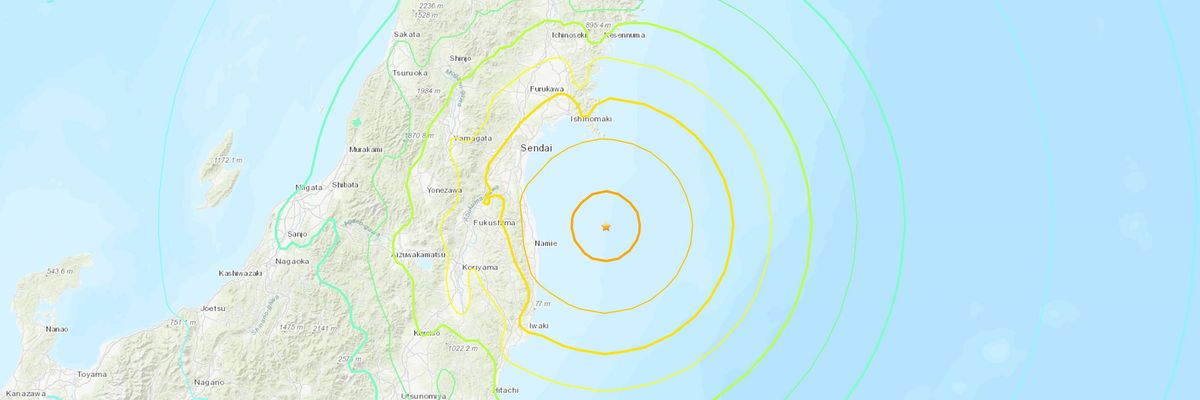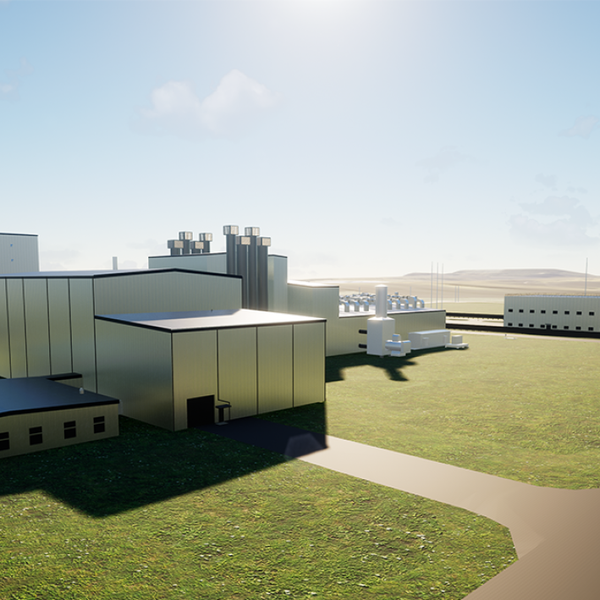
A 7.3 magnitude earthquake hit off the coast of Japan on March 16, 2022, triggering a tsunami warning. (Image: U.S. Geological Survey)
Red Alert for Fukushima Nuclear Plant After 7.3 Quake in Japan
Over two million homes in the Tokyo region were left without power.
This is a breaking story... Please check back for possible updates...
A series of earthquakes off the coast of Japan on Wednesday triggered a tsunami advisory for Miyagi and Fukushima prefectures--just over 11 years after the region endured a major nuclear disaster.
The first two earthquakes, with magnitudes of 6.4 and 7.3, struck within two minutes of each other, followed by another 5.5 magnitude quake over an hour later, according to the U.S. Geological Survey (USGS).
The strongest quake hit about 60 kilometers or 37 miles below the sea and left more than two million homes without electricity in an area serviced by the Tokyo Electric Power Company (TEPCO), the Associated Press reported.
\u201cYes it\u2019s really a 7.3 !\u201d— Eric Feigl-Ding (@Eric Feigl-Ding) 1647441960
The AP noted that TEPCO said workers were checking for any possible damage at the Fukushima Daiichi Nuclear Power Plant in Okuma, the site of the March 2011 disaster--which was caused by a 9.0 magnitude quake and resulting tsunami that led to multiple meltdowns at the facility.
No abnormalities were found at the Fukushima plant, The Japan Times reported, citing the nation's Nuclear Regulation Authority.
TEPCO also found no abnormalities at the Onagawa Nuclear Power Plant in Miyagi Prefecture, according to Japan's public broadcaster, NHK.
"There is a possibility that another earthquake as strong as an upper 6 could strike in the next week or so," Japanese Chief Cabinet Secretary Hirokazu Matsuno told reporters just after midnight local time. "We need to be on alert."
As Common Dreams reported last week, environmental defenders marked the 11th anniversary of the Fukushima disaster with calls for a renewable energy future free of nuclear power.
An Urgent Message From Our Co-Founder
Dear Common Dreams reader, The U.S. is on a fast track to authoritarianism like nothing I've ever seen. Meanwhile, corporate news outlets are utterly capitulating to Trump, twisting their coverage to avoid drawing his ire while lining up to stuff cash in his pockets. That's why I believe that Common Dreams is doing the best and most consequential reporting that we've ever done. Our small but mighty team is a progressive reporting powerhouse, covering the news every day that the corporate media never will. Our mission has always been simple: To inform. To inspire. And to ignite change for the common good. Now here's the key piece that I want all our readers to understand: None of this would be possible without your financial support. That's not just some fundraising cliche. It's the absolute and literal truth. We don't accept corporate advertising and never will. We don't have a paywall because we don't think people should be blocked from critical news based on their ability to pay. Everything we do is funded by the donations of readers like you. Will you donate now to help power the nonprofit, independent reporting of Common Dreams? Thank you for being a vital member of our community. Together, we can keep independent journalism alive when it’s needed most. - Craig Brown, Co-founder |
This is a breaking story... Please check back for possible updates...
A series of earthquakes off the coast of Japan on Wednesday triggered a tsunami advisory for Miyagi and Fukushima prefectures--just over 11 years after the region endured a major nuclear disaster.
The first two earthquakes, with magnitudes of 6.4 and 7.3, struck within two minutes of each other, followed by another 5.5 magnitude quake over an hour later, according to the U.S. Geological Survey (USGS).
The strongest quake hit about 60 kilometers or 37 miles below the sea and left more than two million homes without electricity in an area serviced by the Tokyo Electric Power Company (TEPCO), the Associated Press reported.
\u201cYes it\u2019s really a 7.3 !\u201d— Eric Feigl-Ding (@Eric Feigl-Ding) 1647441960
The AP noted that TEPCO said workers were checking for any possible damage at the Fukushima Daiichi Nuclear Power Plant in Okuma, the site of the March 2011 disaster--which was caused by a 9.0 magnitude quake and resulting tsunami that led to multiple meltdowns at the facility.
No abnormalities were found at the Fukushima plant, The Japan Times reported, citing the nation's Nuclear Regulation Authority.
TEPCO also found no abnormalities at the Onagawa Nuclear Power Plant in Miyagi Prefecture, according to Japan's public broadcaster, NHK.
"There is a possibility that another earthquake as strong as an upper 6 could strike in the next week or so," Japanese Chief Cabinet Secretary Hirokazu Matsuno told reporters just after midnight local time. "We need to be on alert."
As Common Dreams reported last week, environmental defenders marked the 11th anniversary of the Fukushima disaster with calls for a renewable energy future free of nuclear power.
This is a breaking story... Please check back for possible updates...
A series of earthquakes off the coast of Japan on Wednesday triggered a tsunami advisory for Miyagi and Fukushima prefectures--just over 11 years after the region endured a major nuclear disaster.
The first two earthquakes, with magnitudes of 6.4 and 7.3, struck within two minutes of each other, followed by another 5.5 magnitude quake over an hour later, according to the U.S. Geological Survey (USGS).
The strongest quake hit about 60 kilometers or 37 miles below the sea and left more than two million homes without electricity in an area serviced by the Tokyo Electric Power Company (TEPCO), the Associated Press reported.
\u201cYes it\u2019s really a 7.3 !\u201d— Eric Feigl-Ding (@Eric Feigl-Ding) 1647441960
The AP noted that TEPCO said workers were checking for any possible damage at the Fukushima Daiichi Nuclear Power Plant in Okuma, the site of the March 2011 disaster--which was caused by a 9.0 magnitude quake and resulting tsunami that led to multiple meltdowns at the facility.
No abnormalities were found at the Fukushima plant, The Japan Times reported, citing the nation's Nuclear Regulation Authority.
TEPCO also found no abnormalities at the Onagawa Nuclear Power Plant in Miyagi Prefecture, according to Japan's public broadcaster, NHK.
"There is a possibility that another earthquake as strong as an upper 6 could strike in the next week or so," Japanese Chief Cabinet Secretary Hirokazu Matsuno told reporters just after midnight local time. "We need to be on alert."
As Common Dreams reported last week, environmental defenders marked the 11th anniversary of the Fukushima disaster with calls for a renewable energy future free of nuclear power.

